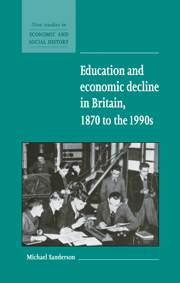Book contents
- Frontmatter
- Contents
- Acknowledgements
- Glossary and abbreviations
- Introduction
- 1 Literacy and schooling, 1870–1914
- 2 Was technical education to blame?
- 3 The counterarguments
- 4 The education of the élite, 1870–1914
- 5 Missed opportunities, 1914–1944
- 6 Post-war decline – the betrayed teenager?
- 7 Higher education and the public schools – privilege and relevance
- Conclusion
- Bibliography
- Index
- New Studies in Economic and Social History
- Studies in Economic and Social History
- Economic History Society
1 - Literacy and schooling, 1870–1914
Published online by Cambridge University Press: 05 June 2012
- Frontmatter
- Contents
- Acknowledgements
- Glossary and abbreviations
- Introduction
- 1 Literacy and schooling, 1870–1914
- 2 Was technical education to blame?
- 3 The counterarguments
- 4 The education of the élite, 1870–1914
- 5 Missed opportunities, 1914–1944
- 6 Post-war decline – the betrayed teenager?
- 7 Higher education and the public schools – privilege and relevance
- Conclusion
- Bibliography
- Index
- New Studies in Economic and Social History
- Studies in Economic and Social History
- Economic History Society
Summary
Let us begin by considering the condition of literacy. In the period from 1870 to 1913 Britain achieved virtually total literacy in the workforce. As measured by the capacity to sign one's name literacy rose from 80 per cent in 1870 to 97 per cent by 1900 (Stone, 1969; Baines, 1981). Even among the criminal classes only 19.3 per cent were still illiterate by 1898 (Harris, 1993 p. 213). In Scotland literacy rose from 90 per cent in 1870 to 98 per cent in 1900 for men and from 80 per cent to 97 per cent for women over the same period (Anderson, 1997, p. 39). David Vincent has analysed the trend to mass total literacy by social groups (Vincent, 1989 p. 97). See table 1.1.
The rise in literacy is seen across the spectrum of occupations. Whereas only social classes 1 and 2 were almost all literate by the 1870s this position was achieved for most of the rest by 1904–9 and was virtually total for all groups by 1914. For some the advance was remarkable, especially for metal workers and miners who made 25 and 52 percentage point gains from the 1870s to 1914. Textile workers and miners, the notorious literacy laggards of the Industrial Revolution before 1830, achieved total literacy by 1914. So it was for their womenfolk where brides are considered by the occupation of their fathers (Vincent, 1989 p. 102). See table 1.2.
Various factors lay behind this. There was a gradual extension of compulsory education (Lowndes, 1969).
- Type
- Chapter
- Information
- Publisher: Cambridge University PressPrint publication year: 1999



